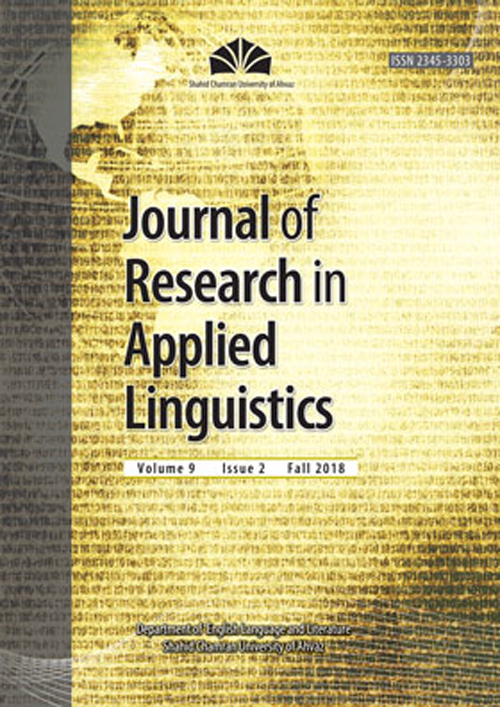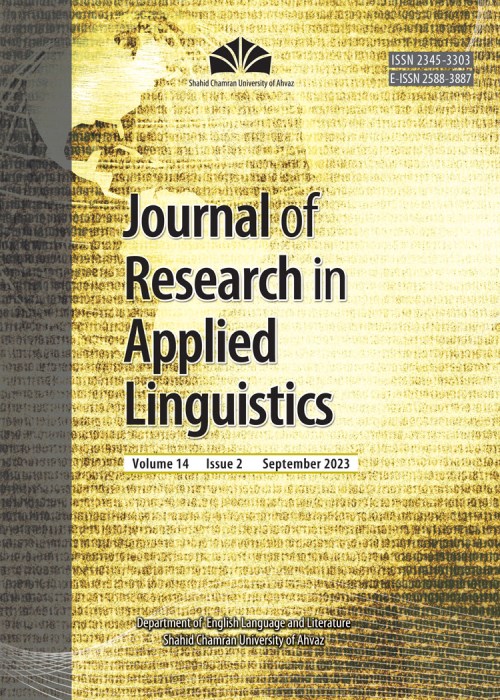فهرست مطالب

Journal of Research in Applied Linguistics
Volume:9 Issue: 2, Autumn 2018
- تاریخ انتشار: 1397/07/24
- تعداد عناوین: 7
-
-
Pages 3-23This study investigated the effectiveness of reactive incidental focus on form (FonF) for each learner with regard to different linguistic categories in meaning-oriented EFL classes. To this end, 30 hr of meaningful interactions of upper-intermediate EFL learners were audio-recorded in 2 free discussion classes. Instances of reactive incidental focus-on-form episodes (FFEs), where teachers offer on-the-spot corrective feedback to their learners’ linguistic mistakes, were extracted from the data. Furthermore, individualized tailor-made posttests were designed out of self-reported novel FFEs per learner. Results of learner-customized immediate and delayed posttests indicated that this type of instruction led to a substantial improvement in learning the focused language points. Achievement rates were found to be high in both test administrations. This efficacy was, however, more noticeable with regard to grammatical and phonological FFEs. Results reveal that reactive incidental FonF could enhance explicit knowledge of L2 learners both in the immediate context based on uptake rate and in the long run, as the findings from the immediate and delayed posttests demonstrated.Keywords: Reactive Incidental Focus on Form (FonF), Long-Term Effectiveness, Short-Term Effectiveness
-
Pages 24-46This study was an attempt to examine the supervisors’ and graduate students’ needs for written feedback on thesis/dissertation and juxtaposed them to see how each group views feedback. A mixed-methods design was employed to collect the data. Questionnaires and interviews were deployed to collect the data from 132 graduate TEFL students and 37 supervisors from 10 Iranian Universities. Results indicated that there were similarities (argument, logical order, transition, clarity, and references decisions) and differences (inclusion of information, formatting, grammar, conclusion, introduction, and consistency) between the priorities given by the M.A. and Ph.D. students. Moreover, the findings indicated that the M.A. students’ expressed priorities were not similar to those of the supervisors except in 3 areas (argument, formatting, and grammar). On the contrary, the supervisors’ priorities were close to those expressed by the Ph.D. students in almost all cases. Different factors underlying the perceptions of the students and supervisors were also extracted and presented. Some implications and suggestions for further research are proposed.Keywords: Written Feedback, Thesis, Dissertation, Graduate Students, Supervisors, TEFL
-
Pages 47-73This study examined disciplinary rhetoric in research articles, focusing on different traditions in structuring text discourses from a metadiscourse-move analytic approach. The corpus consisted of 72 research article Introductions (RAIs): 36 in applied linguistics and 36 in chemistry. Swales’ CARS model (1990, 2004) and Hyland’s interpersonal model of metadiscourse (2005) were used as analytical frameworks for move and metadiscourse analyses, respectively. Both frequency and functional analyses showed that there were considerable differences between the 2 disciplines in terms of how the writers used metadiscourse in the RAIs and how the metadiscourse markers were mapped to fulfill the rhetorical purposes of Introduction moves. Such discrepancies reflect the susceptibility of metadiscursive features to the sociorhetorical cultures conditioned by the discipline to which the writers belong. Findings have implications for teaching novices, especially nonnative speakers of English, to write research articles and help them create a convincing research space and make appropriate use of metadiscourse.Keywords: Disciplinary Community, Genre, Metadiscourse, Move, Research Article Introductions (RAIs)
-
Pages 74-100Recently, constructing professional identity has received an increasing attention. By adopting and adapting analytical tools of critical discourse analysis (CDA), this study explored the ways through which identities of the qualitative researchers had been projected in 4 applied linguistics articles. This study intended to find out whether the authors of qualitative research articles in applied linguistics tended to prioritize particular linguistic elements in representing their identities. Detailed descriptive analyses based on 4 CDA and discourse analysis taxonomies revealed that the qualitative researchers had a particular pattern to show human and nonhuman social actors in their writings. Human social actors (teachers and learners) were preferred to nonhuman social actors (textbooks), and teachers were the focus of attention more frequently than learners. Also, human social actors were considered as individuals, rather than groups in the majority of cases. In addition, mental processes were found to be employed more than material processes in order to contribute to the subjective interpretation and greater visibility for the researchers. Although the linguistic devices which help human social actors to be seen more vividly like inclusion and activation were used more than other devices, elements like transition, self-mentions, hedges, and code glosses were also employed. Findings may be considered useful for teachers and educators and may help them become more self-conscious about identity issues embedded in research articles.Keywords: Applied Linguistics Research Articles, Critical Discourse Analysis (CDA), Qualitative Researchers, Researcher Identity, Teacher Education
-
Pages 101-117In light of the Bakhtinian heteroglossia and authorial hybrid construction, the present study sets out to argue how the assimilation of alien stylistics into the realm of social and ideological discourse may transcend the limits of the centralizing logos prevalent in the orthodox poetics. In so doing, first, an analysis of the Bakhtinian concepts is provided to renegotiate his argument on the aesthetic and rhetorical capacities of the prose fiction vis-à-vis the totalitarian poetic discourse. Accordingly, as an innovation, this study suggests that the subversive potentiality of a text stems from both its carnivalesque interrelatedness with a dominant culture and its capability to transcend the limits of the said culture and to revitalize its synchronic and diachronic affiliations to other cultures. To confirm this, a good array of examples is drawn from novelistic texts. In Gunter Grass’s The Tin Drum, the protagonist’s mocking attitude towards centripetal fatherhood and his going ahead of clock strokes and hence weaving here-and-now to there-and-then so as to claim possession of his once-beloved woman is a significant case in point. Thus, not only can the marginalized utterances deal with patriarchies of the dominant culture, but also they can restructure their independent sphere based on their internal and external exigencies.Keywords: Answerability, Context Multiplicity, Dialogism, Heteroglossia, Novelistic Utterances
-
Pages 118-140This study investigated teachers’ conceptions of intelligence (TCoI) and ambiguity tolerance in the burnout levels of 202 Iranian EFL teachers. To this end, 3 inventories were utilized: Language Teachers’ Conceptions of Intelligence Scale (LTCI-S), Multiple Stimulus Types Ambiguity Tolerance Scale-II (MSTAT-II), and Maslach Burnout Inventory (MBI). Pearson multiple correlation coefficients and path analysis were employed for the data analysis. Results exhibited significant relationships among TCoI, ambiguity tolerance, and teacher burnout. Moreover, the results indicated that increasibility and applied ELT subscales of TCoI were negative significant predictors of emotional exhaustion and reduced personal accomplishment dimensions of teacher burnout. Additionally, ambiguity tolerance was found to be a negative significant predictor of all teacher burnout dimensions. Finally, the results are discussed and implications are provided in the context of education.Keywords: Ambiguity Tolerance, Path Analysis, teacher burnout, Teachers’ Conceptions of Intelligence (TCoI)
-
Pages 141-161An increasing number of studies have investigated the effects of different types of corrective feedback. However, doubts have been raised whether field (in)dependent (FI/FD) L2 learners benefit differently from the explicit type of corrective feedback (i.e., metalinguistic). This study examined the (possible) effects of metalinguistic feedback on FI/FD intermediate L2 learners’ writing accuracy. To this aim, 52 Iranian intermediate L2 learners in intact classes were classified into FI/FD learners through Group Embedded Figures Test (GEFT). They were, then, randomly assigned into 2 experimental and 1 control groups. Experimental groups received metalinguistic feedback and the control group received no feedback. Two sample IELTS tests (i.e., the Writing section) were used as the pretest and posttest to measure the participants’ learning of English articles as a result of metalinguistic feedback. Data were analyzed through ANCOVA and post-hoc. Although the results revealed that both the FI/FD learners benefited from metalinguistic feedback, the FD participants outperformed the FI ones. Findings have implications for L2 teachers and researchers to help L2 learners with different cognitive styles to improve their writing accuracy.Keywords: Corrective Feedback, Field (In)dependent, Metalinguistic Feedback, Grammatical Accuracy, Writing Ability


